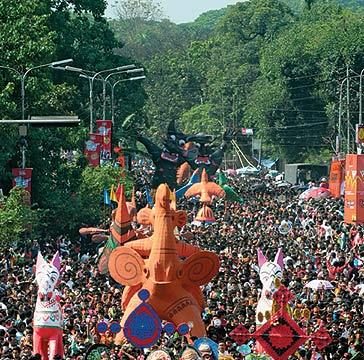Dhaka had never entered the same thought bubble as ‘travel’ in my mind but if ever there was a time to travel to Dhaka, it was in early April — the lead up to the Bengali new year — Poila Boishakh, which is the first day of the month of Boishakh in the Bengali calendar. I had not an inkling of the festive spirit I was about to be swept away by when I flew into Dhaka a few days before the New Year. I had been invited by the Indian High Commission in Dhaka to sing before the celebrations of Rabindranath Tagore’s 150th birth anniversary ended in May, and I was vaguely excited that I was going to the land of my ancestors.
Growing up in a large joint family in Calcutta, I am inured to the idea of making a festive occasion out of nothing at all but Poila Boishakh was a calm affair. We’d wear crisp new clothes — there’d be some excitement around procuring those — and spend time in each aunt’s room (in typical joint family fashion, our house had fluid spaces and only certain spaces could be called one’s own room), touching elders’ feet and gorging on mishti.
Dhaka was very different. In the days leading up to Poila Boishakh, each time we stepped out, the streets looked that little bit more festive — a few more buildings twinkled with garland lights, paper flags criss-crossed streets, roundabouts slowly transformed with board cut-outs and, despite the rising temperature, people looked cheerful at the thought of the holiday ahead.
Invited to sing in a festival on the eve of the New Year, I was taken aback by the scale of the event — there seemed to be thousands of people milling around. Old and young alike were listening to live music organised by the cultural outfit Shurer Dhara. Backstage, we learnt that children from Dhaka’s slums were being trained by the organisation to sing Tagore’s songs. We waited for their performance and they all looked jolly in brand-new clothes. It struck me, that despite the throngs, the whole affair was calm and smooth, and I was overcome by a sudden surge of Bengali nationalism — how wonderful to be one among these people united by music on a special day!
Earlier that morning, I had visited the Bangabandhu Memorial Museum named after Sheikh Mujibur Rahman, and my memory of that visit and the historical contexts it evoked made the event all the more poignant. Celebration of Poila Boishakh began in Dhaka as a way of protesting the ban of Tagore’s poems by the Pakistani government. In order to weaken the movement for an independent state from Pakistan which had begun in Bangladesh in the late 1940s — as well as suppress Bengali culture and create a distinction between Bengali Muslims and others — Tagore’s poems were banned. Rejecting this attempt, in 1965, the cultural organisation Chhayanat celebrated Poila Boishakh by ushering in the day with Tagore’s Boishakhi songs. To this day, New Year festivities begin under a banyan tree at Ramna Park with Tagore’s ‘Esho he boishakh esho esho’ — a song to mark the onset of summer and the New Year. Though I have always enjoyed singing Rabindrasangeet, the Bengali obsession with it had seemed to me an unavoidable cultural malaise. In Dhaka, for the first time, I felt deeply the extent to which Tagore, his poetry and his music binds Bengalis together.
To add to the festivities, Charukala, the fine arts institute of Dhaka University, organises a Shobha Jatra — a colourful parade around the campus with floats made by artists in the university. The city of Dhaka spilled out on the streets to watch the parade, roam the Boishakhi fairs, participate in alpona competitions and have the traditional panta ilish — watery rice with fried hilsa, eaten with chillies and onions — for lunch. It was the jolliest way to begin the year. As we’d say in Bengali, Shubho Noboborsho.




